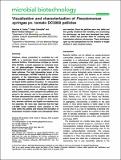Por favor, use este identificador para citar o enlazar a este item:
http://hdl.handle.net/10261/184945COMPARTIR / EXPORTAR:
 SHARE SHARE
 CORE
BASE CORE
BASE
|
|
| Visualizar otros formatos: MARC | Dublin Core | RDF | ORE | MODS | METS | DIDL | DATACITE | |

| Título: | Visualization and characterization of Pseudomonas syringae pv. tomato DC3000 pellicles |
Autor: | Araujo Farias, Gabriela de CSIC; Olmedilla, Adela CSIC ORCID; Gallegos, María Trinidad CSIC ORCID | Fecha de publicación: | 2019 | Editor: | John Wiley & Sons | Citación: | Microbial Biotechnology (2019) | Resumen: | Cellulose, whose production is controlled by c-di-GMP, is a commonly found exopolysaccharide in bacterial biofilms. Pseudomonas syringae pv. tomato (Pto) DC3000, a model organism for molecular studies of plant–pathogen interactions, carries the wssABCDEFGHI operon for the synthesis of acetylated cellulose. The high intracellular levels of the second messenger c-di-GMP induced by the overexpression of the heterologous diguanylate cyclase PleD stimulate cellulose production and enhance air–liquid biofilm (pellicle) formation. To characterize the mechanisms involved in Pto DC3000 pellicle formation, we studied this process using mutants lacking flagella, biosurfactant or different extracellular matrix components, and compared the pellicles produced in the absence and in the presence of PleD. We have discovered that neither alginate nor the biosurfactant syringafactin are needed for their formation, whereas cellulose and flagella are important but not essential. We have also observed that the high c-di-GMP levels conferred more cohesion to Pto cells within the pellicle and induced the formation of intracellular inclusion bodies and extracellular fibres and vesicles. Since the pellicles were very labile and this greatly hindered their handling and processing for microscopy, we have also developed new methods to collect and process them for scanning and transmission electron microscopy. These techniques open up new perspectives for the analysis of fragile biofilms in other bacterial strains. | Versión del editor: | https://sfamjournals.onlinelibrary.wiley.com/doi/full/10.1111/1751-7915.13385 | URI: | http://hdl.handle.net/10261/184945 | DOI: | 10.1111/1751-7915.13385 | Identificadores: | doi: 10.1111/1751-7915.13385 issn: 1751-7915 |
| Aparece en las colecciones: | (EEZ) Artículos |
Ficheros en este ítem:
| Fichero | Descripción | Tamaño | Formato | |
|---|---|---|---|---|
| 2019_Farias_MB_OA.pdf | 4,75 MB | Adobe PDF |  Visualizar/Abrir |
CORE Recommender
PubMed Central
Citations
11
checked on 01-may-2024
SCOPUSTM
Citations
17
checked on 28-abr-2024
WEB OF SCIENCETM
Citations
14
checked on 24-feb-2024
Page view(s)
185
checked on 30-abr-2024
Download(s)
321
checked on 30-abr-2024

